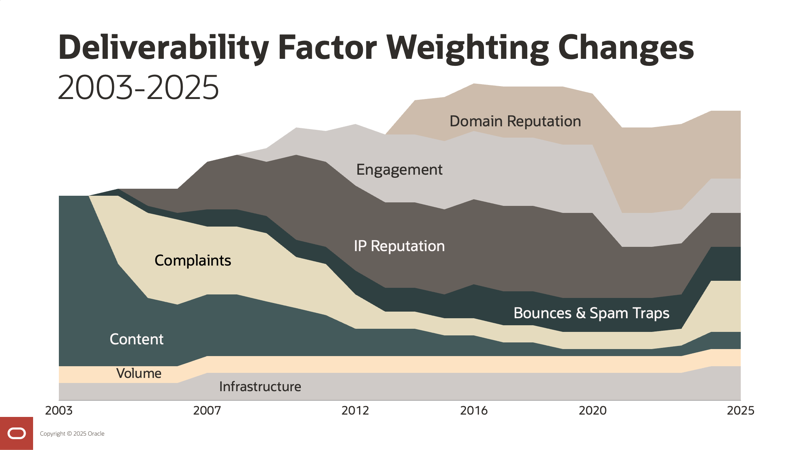Many marketers don’t give email deliverability much attention—that is, until they have a crisis on their hands that’s tanking their email marketing results. Still others have simply accepted their average or even below-average inbox placement rates because they think it’s normal or feel they can’t change it.
Across the email marketing industry, deliverability rates average 85%, according to Validity. However, the Oracle Digital Experience Agency clients who work with our Email Deliverability Services team have an average deliverability rate of 97%. For an email marketing program that generates $10 million in revenue annually, boosting its deliverability rate from 85% to 97% can mean up to $1.4 million in additional revenue.
How do we help our clients attain such high inbox placement rates? We do it by paying attention to…
The 7 Factors that Impact Email Deliverability
Since the mid-2010s, maintaining strong inbox placement has been about understanding and managing your:
- Email marketing infrastructure
- Email volume
- Email content
- Spam complaints
- Bounces and spam trap hits
- Engagement rates
- IP and domain reputations
For a discussion of each of those factors, as well as their subfactors, watch the 54-minute on-demand webinar below. But for the remainder of this post, let’s discuss which factors have become more important and less important over time.
How Email Deliverability Has Changed over Time
While your sending infrastructure and email volume management have been steady in their importance since the passage of the CAN-SPAM Act in 2003, other factors have varied wildly, based on the experiences and observations of our Email Deliverability Services team over time.
For example, your email content used to be incredibly important, particularly the text of your email. Although lists of spammy words are still circulated online, word choices have become largely irrelevant and content in general much less important. Today, it’s the coding of your emails and the reputations of the URLs you link to that are impactful.

Complaints have dwindled in importance since the 2010s, but have seen a resurgence with the new deliverability requirements from Google and Yahoo, which require senders to keep their spam complaint rates under 0.1%, and absolutely under 0.3% for any significant span of time.
While engagement was tremendously important to managing deliverability in the 2010s, Apple’s launch of Mail Privacy Protection has dramatically undermined the usefulness of opens, which were the dominant engagement signal. At the same time that they made it harder for senders to see if their subscribers were engaging with their emails, Apple gave marketers auto opens, which is ultimately an inbox placement signal, since auto opens are only triggered when an email lands in the inbox. While not as strong a signal as engagement, auto opens have allowed some senders to expand their audiences and safely send to subscribers who haven’t shown any reliable signs of engagement in a long time.
And finally, while the sender reputation that’s attached to the IP address(es) you use to send your emails is still important, the sender reputation attached to your domain has become much more so. This shift has made senders much more accountable for their behaviors, because while it’s possible to change your sending IP addresses and subdomain in an effort to walk away from a bad reputation, brands can’t walk away from their top level domain without upending their businesses.
The past two years have been a time of major change for the world of email deliverability, with mailbox and inbox providers making big investments in improved spam filtering, new policy initiatives, and new inbox features. We see that in the new deliverability requirements from Gmail, Yahoo, and Microsoft. Collectively, these changes will hold email senders to a higher standard and make staying in the inbox more difficult, especially in the near term.
—————
Need help with your email marketing program? Oracle Digital Experience Agency has hundreds of marketing and communication experts ready to help Responsys, Eloqua, Unity, and other Oracle customers create stronger connections with their customers and employees—even if they’re not using an Oracle platform as the foundation of that experience. With a 94% satisfaction rate, our clients are thrilled with the award-winning work our creative, strategy, and other specialists do for them, giving us an outstanding NPS of 82.
For help overcoming your challenges or seizing your opportunities, talk to your Oracle account manager, visit us online, or email us at OracleAgency_US@Oracle.com.
To stay up to date on customer experience best practices and news, subscribe to Oracle Digital Experience Agency’s award-winning, twice-monthly newsletter. View archive and subscribe →
Now completely updated, this post was originally published on June 9, 2020 by Daniel Deneweth and Chad S. White.


